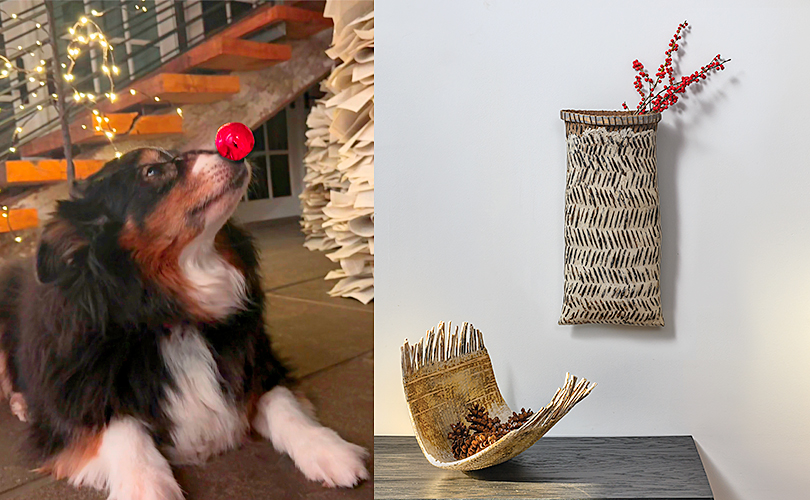
We’re beginning our holiday revelry early this year!
Here’s round up of Holiday images.
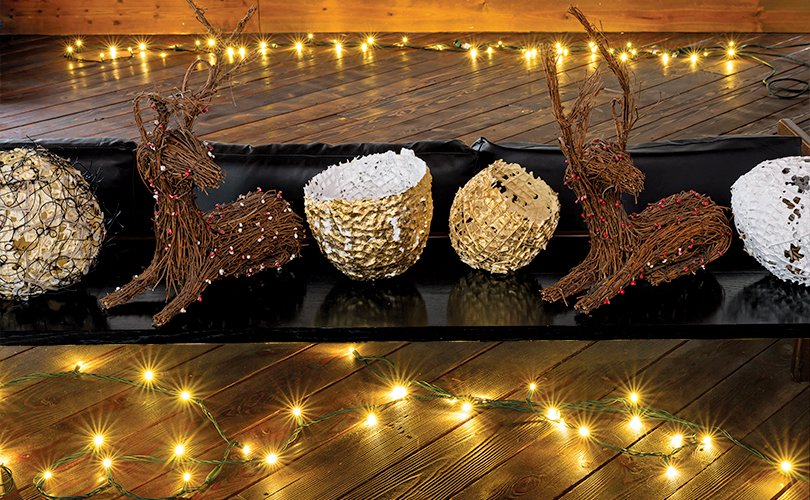

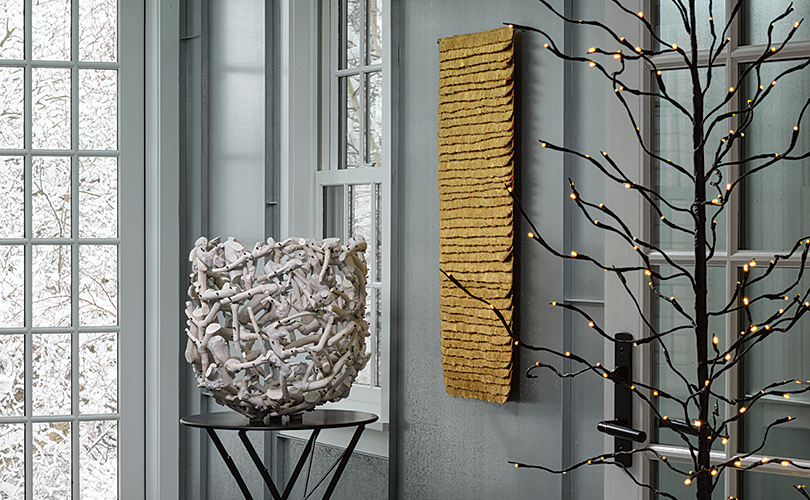
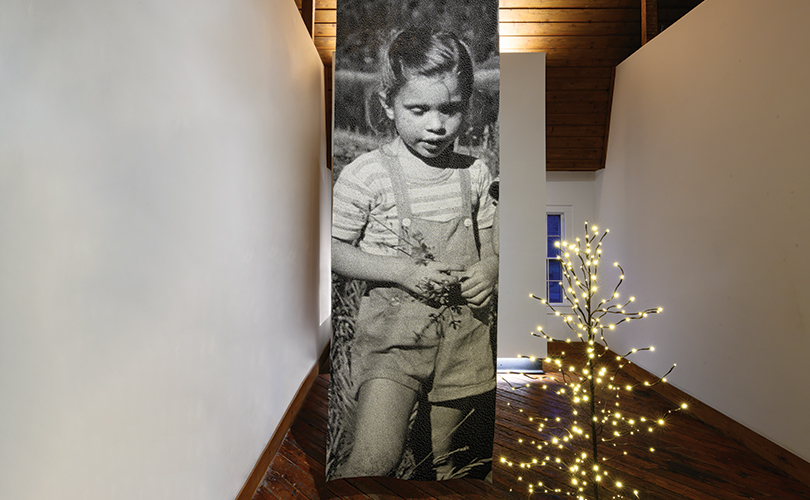
Wishing you all a most enjoyable holiday season!

We’re beginning our holiday revelry early this year!
Here’s round up of Holiday images.




Wishing you all a most enjoyable holiday season!

One more artist recommendation this week, from Wendy Wahl. “I came upon ROPE: How a Bundle of Twisted Fibers Became the Backbone of Civilization, by Tim Queeny, in The New York Times Book Review,” Wahl writes. “He had me lassoed when he gave credit to Elizabeth Wayland Barber’s Women’s Work, The First Twenty Thousand Years. Women, Cloth, and Society in Early Times. Queeney’s brief book is packed with history as he describes a rope fragment estimated to be 50,000 years old, discovered in southeast France, and a 4,000 year old Egyptian rope utilizing the “s” and “z” twist construction. For the nautical, you will find examples of fiber boats, lines, knots, the role in sailing navigation, and gathering food from the sea. He describes how the rope was used to build pyramids, the Incan Quipu, a portable rope with knots for communication, and rope as a means to reach the divine through mythology. He shows us how rope was used in underground mines, for travel in balloons and airplanes, for working with horses and livestock, for containment, inflicting punishment, and for magic and marriage. His concise chapters twist and turn, explaining how plant and animal materials were first used, the transition to metal and plastic rope making, and yarns of the future. He shares stories of mountain climbers and cavers, as well as Petit Philip, a tightrope artist who walked between the Twin Towers in 1974, and the use of rope in science and space exploration. I was hoping he would include the role of rope for looms, as well as its use as a material metaphor by artists. Otherwise, the book jacket is spot on, describing ‘A unique and compelling adventure through the history of rope, and its impact on civilization.‘”
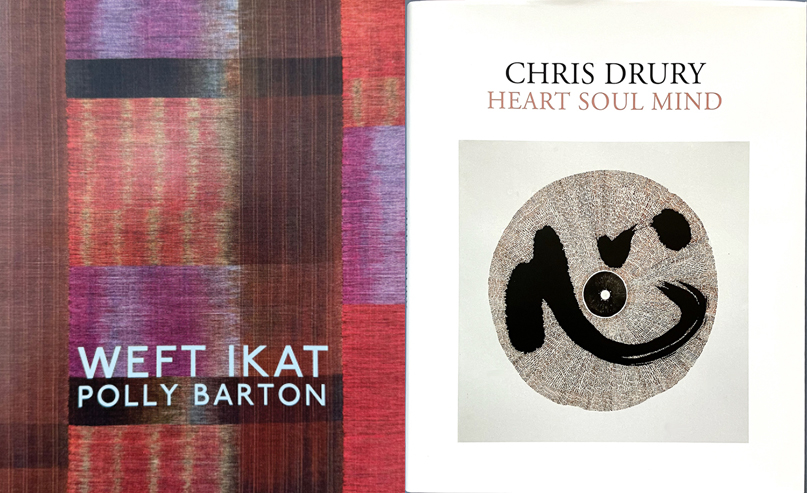
At browngrotta arts we’ve also come across a number of interesting books this year. On our website, you’ll find Weft Ikat: Polly Barton. Self published by the artist, Sutton shares the basic tying techniques for weft ikat and some techniques she has adapted to solve design problems. Ikat means a to bind a group or skein of fibers with a resist tie to create a pre-calculated design when the fibers are woven. The technique is one that is used in differing combinations by cultures across the world.
We can also recommend Chris Drury: Heart Soul Mind. The book, as advertised, “gives in images and the words of Chris Drury himself, a precious insight into this renowned artist’s practice over more than four decades.” Drury has long focused on patterns of energy, in plants, wind, water, and the flow patterns of blood in the human heart, relating systems in the body to systems on the planet. In the book, he tells stories behind his land art constructions of soil, wood, stone, and fungi in vastly different landscapes from Japan to South Korea to Nevada, Scotland, Antarctica, Wyoming, and Australia. Frequent collaborator, poet Kay Syrad, contributed the introduction. The photographs are large and affecting. As the book jacket concludes,”Drury’s works remind us that art too can transform the way we look at the world.” Of course, books can, too.

We were gifted a truly exquisite book when Tom, Rhonda, and Carter traveled to Paris in March. For its 15th-anniversary exhibition, Maison Parisenne commissioned 15 exceptional works by 15 renowned artists such as Simone Pheulpin, whose work we show in the US, Pierre Renart, Hervé Wahlen, Gérald Vatrin, and others. The works were showcased at the historic Hall des Maréchaux within the Musée des Arts Décoratif and documented in Maison Parisienne: 15 Years. The photos in the book are beautiful, the work striking, but what impressed us most was the accuracy of the title of the introduction, “Maison Parisienne, a gallery as a universal family.” Oliver Gabet, Director, Department of Objets d’Art, Musée du Louvre, describes the care with which the gallery’s founder, Florence Guillier-Bernard, selects the artists that she promotes so energetically and effectively, an approach familiar to us. “… [T]here can be no doubt that she also chose the name with equal care,” he writes, “maison conjuring up a house that is also a home and a focal point for a family of disparate kith and kin, linked by networks of hidden connections.” The portraits of Guillier-Bernard with various artists represented by the gallery are a testament those eviable connections. We are pleased to have our own connection to this meticulously curated collection.
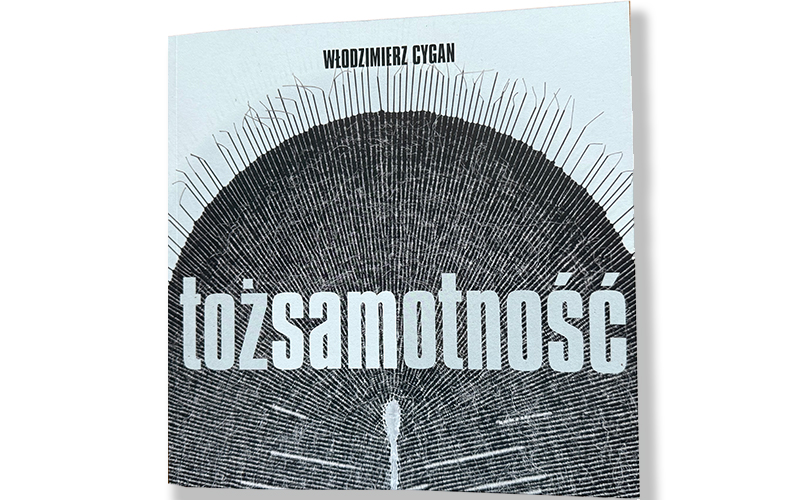
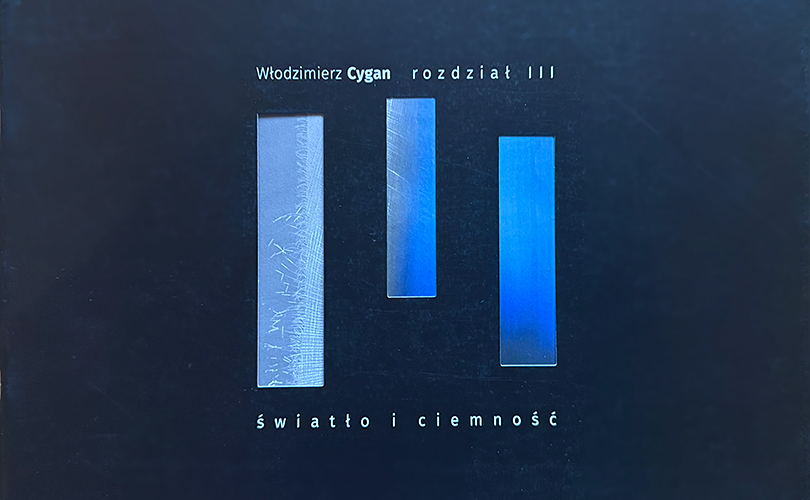
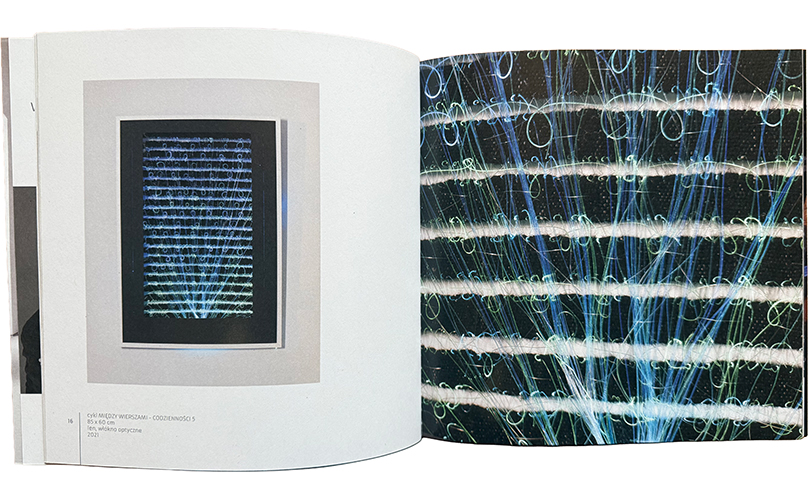
Wlodimirez Cygan shared two beautiful catalogs with us in May, Tożsamotność (Loneliness) and Światło i ciemność (Separation of Light and Darkness). Cygan wrote that the Tożsamotność (Loneliness) exhibition presented selected textiles created after 2008, when he finished working for Academy of Fine Arts in Gdańsk. “All of them make a reference to the textile – light and textile — interior relationship. In some works it is an interpretation of light; in others – light implemented in the living tissue of the creation.” The text of the catalog is in Polish, but the photographs — many of them full page — are luminous. We are excited that browngrotta arts will exhibit two of the works in this catalog — Organic 3 and Between the Lines of Everyday Life 5, in its May 2026 exhibtion. In the Światło i ciemność (Separation of Light and Darkness) catalog, the text is in Polish and English, and again, the illustrations are dramatic, many of them of the artist’s works in black and white. In a reference pertinent to this body of work, essayist Marta Kowalewska writes, “Deliberately limiting the range of colors and color effects, associated to a great extent with painting, as well as defending against purely sculptural treatments, [he] strengthens those values that make up the essence of textile art,” she writes. “The technical constraints become an ally of the artist; sensuality of the fiber builds sensuality of the pieces …. Range of black, gray, and white allows perception of the mastery of the weave, perfection of design, but ultimately leads viewers’ attention to poetics of the communication.”

Contemporary Basketry: New Directions from Innovative Artists Worldwide is a new work by Janet Koplos and Carol Eckert. Inspired by Eckert’s blog, “Contemporary Basketry,” the book profiles 60 international artists (15 of whom have been promoted by browngrotta arts). A comment by each artist is included and Koplos has contributed an insightful essay, “Looking Into Baskets,” that discusses architecture, technique, allusion, and other attributes of contemporary practice. She borrows sculptor Phyllida Barlow’s term “restless objects,” noting baskets are restless in being unfixed in time, being portable and not fixed in place, and the artists who make them are restless, interested in defying expectations and distinguishing their works.
A book from 2024 was particularly relevant for us this year. From the perspective of artists, the browngrotta arts’ exhibition, Beauty is Resistance: art as antidote, explored the impact of art on anxiety, pain, mood, and memory. In Your Brain on Art: How the Arts Transform Us, authors Susan Magsamen and Ivy Ross report on the scientific research supporting those effects — on physical health, cognitive development, and memory. The findings cited are truly remarkable — engaging in art for 45 minutes straight can lower cortisol levels, learning music improves cognitive skills, striking tuning forks lower stress, and museum visits are prescribed to treat dementia and depression. Also featuring conversations with artists such as David Byrne, Renée Fleming, and evolutionary biologist E. O. Wilson, Your Brain on Art, is an authoritative guide to neuroaesthetics.
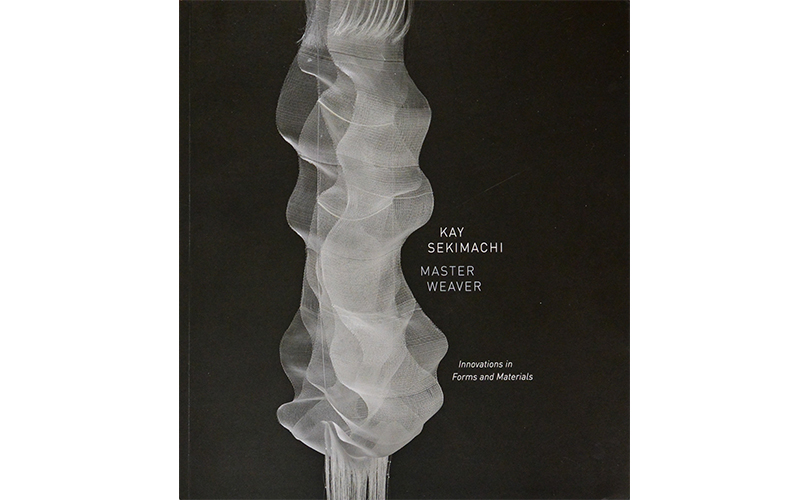
We have acquired more copies of Kay Sekimachi: Master Weaver, Innovations in Forms and Material, published by the Fresno Art Museum to celebrate Sekimachi’s selection for the Council of 100 Distinguished Women Artists for 2018. The catalog, available on our website, covers the expanse of Sekimachi’s career. It includes a comprehensive essay by Mija Riedel, “Thinking Through Thread,” a detailed chronology by Signe Mayfield, and exquisite photography by M. Lee Featheree. “Over six decades, Sekimachi has become a virtuoso of thread and form,” Riedel writes .… “She has bent, sewn, and molded paper into three-dimensional objects we haven’t seen before that can stand on their own and fill with light.”
May your 2026 reading list also be filled with light!
We’ve got book and exhibition recommendations from artists on tap this week and recommendations from browngrotta arts next.
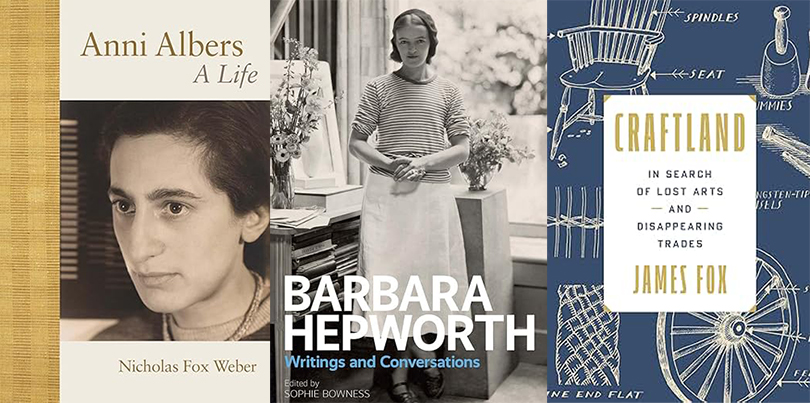
Rachel Max is looking forward to reading a new biography of Anni Albers, by Nicholas Fox Weber (Anni Albers: a life), which is coming out in April next year. “But,” she writes, “whenever I need a burst of inspiration, I dip into the Writings and Conversations, by Barbara Hepworth. I’ve always loved her work. Max also recommends Craftland by James Fox as a thoughtful and timely journey through Britain’s “endangered” crafts and heritage.
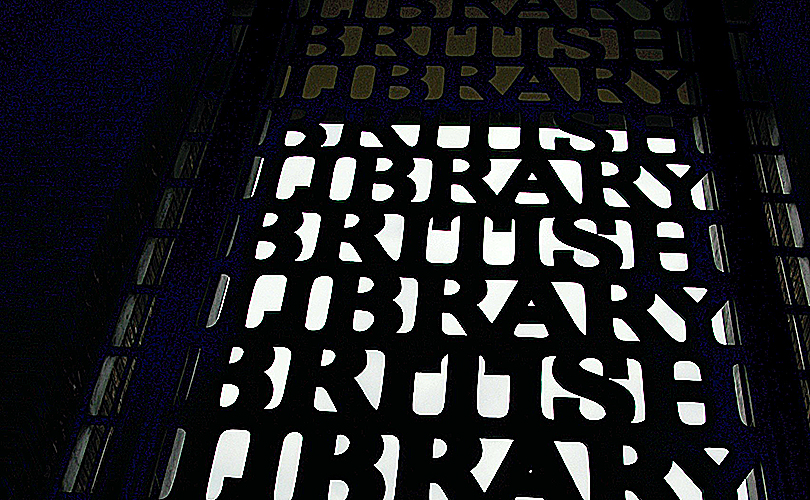
“In a digital age where handmade skill is gradually being chiseled away by mass production and AI, Fox traverses both time and land to meet some of the people keeping our need for craftsmanship alive. As a maker, I am extremely conscious of techniques – not reviving them as such, but reviewing them to make something new. Admittedly, and perhaps because I live and work in a city, I take lots for granted – how agriculture, for example, has shaped our landscape with hedgerows and stone walls. I’ve always known that Sheffield is famous for its steel production, that Birmingham has a long history of jewelery making, and that Somerset is known for willow weaving. Each area has its own unique way of doing things – stone walls and baskets vary from region to region. I’ve walked past the British Library many times without considering who designed and carved the lettering on the facade. The bells of Big Ben toll across our screens every New Year, but, like many, I take for granted the skill and expertise that went into making and tuning them.
Fox’s writing is poetic and contemplative but what comes acoss most in this book are the skills, dedication and determination of all the people he met along the way,” Max says. “Aside from the rush weaver, Felicity Irons, many names were unknown to me, but these names and their workmanship are hardly invisible, they are part of a far greater picture – our social and cultural history. So much so that once forgotten trades have become embedded in our own names and language. Fox reminds us to look around, to notice and to take note of crafts enduring legacy.”
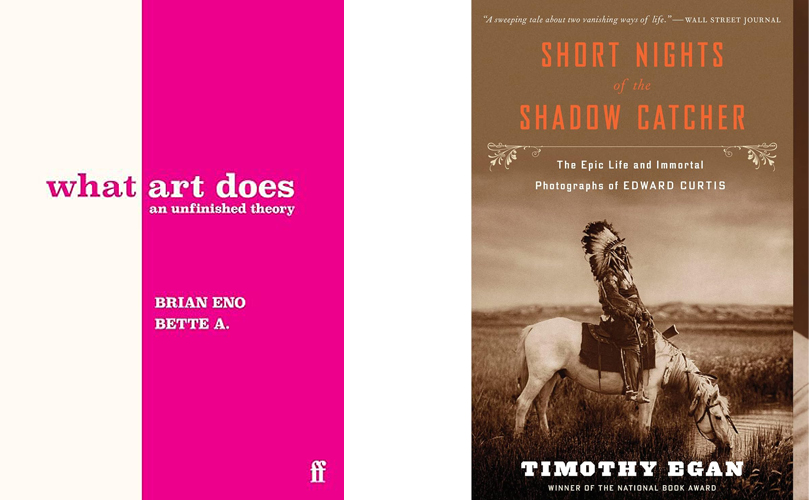
“I can recommend What Art Does: An Unfinished Theory, by Brian Eno and Bette A.,” Randy Walker writes. “It’s a small book (literally 3” x 5”) consisting of 122 refreshing pages written and illustrated in children’s book fashion — just my style. I savor the thoughts, and only read a few pages at a time so I can contemplate them for a while.” The book is billed as “an inspiring call to imagine a different future.”
“My favorite book of the year was about photographer, Edward Curtis — Short Nights of the Shadow Catcher: The Epic Life and Immortal Photographs of Edward Curtis by Timothy Egan,” writes Polly Sutton. “I recently got to view photos at the Rainier Club in Seattle where he lived for many years and paid for his room and board with pictures.”
According to the publisher’s notes, Curtis spent three decades documenting the stories and rituals of more than 80 North American tribes. It took tremendous perseverance — 10 years alone to persuade the Hopi to allow him to observe their Snake Dance ceremony. And the undertaking changed him profoundly, from detached observer to outraged advocate. Curtis would amass more than 40,000 photographs and 10,000 audio recordings, and he is credited with making the first narrative documentary film. The Ranier Club has an important collection of his works.
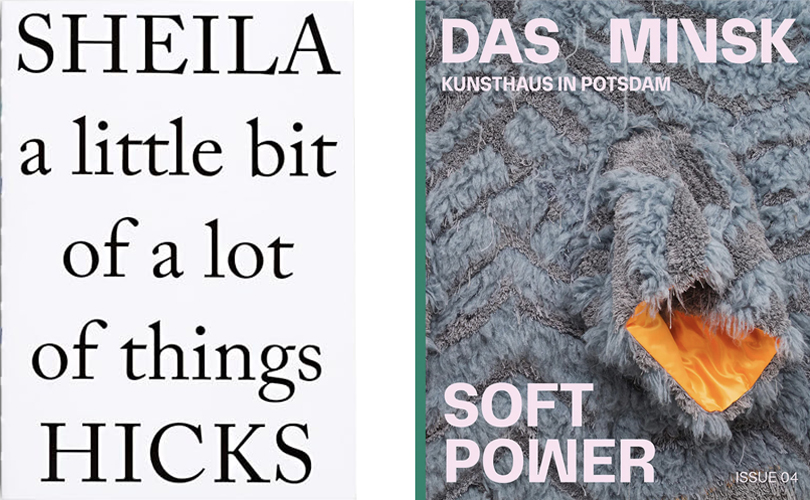
Exhibition catalogs often inspire recommendations; Europe was apparently the source for fiber exhibitions in the last 12 months, based on Heidrun Schimmel’s update. The expansive exhibition of Sheila Hicks: a little bit of a lot of things was a highlight this year In Germany, Schimmel writes. The exhibition was shown in Kunsthalle Düsseldorf from October 2024 to February 2025. “A very good catalog of the same name was published,” she writes. It chronicles 50 years of the artist’s work and features a lay-flat sewn binding and an exposed spine, A Little Bit of a Lot of Things is designed to emulate Hicks’ playful, imaginative practice.
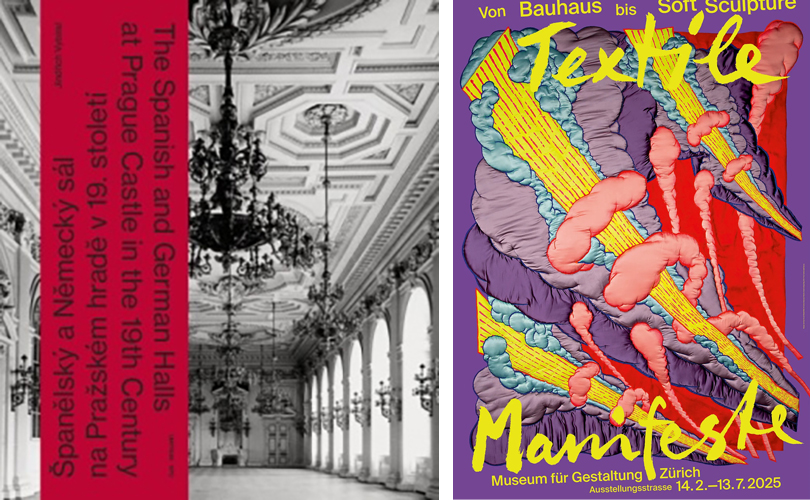
“Another good exhibition, Soft Power, was shown in the Museum Das Minsk, Potsdam, Germany, in 2024, she says. You can order the exhibition catalog (112 pages) and take on line tour here: https://dasminsk.de/en/exhibitions/4478/soft_power. A truly comprehensive exhibition, Textile Manifestos—From Bauhaus to Soft Sculpture, was displayed in Switzerland, in the Museum für Gestaltung, Zürich, she says. In addition to the fiber all-stars — Hicks, Tawney, Abakanowicz — the exhibition included intriguing artists Gunta Stölz, Elsi Giaque, Lia Cook, and Masakazu Kobayashi. In conjunction, the Museum recommends the volume, Textiles Manifestos.
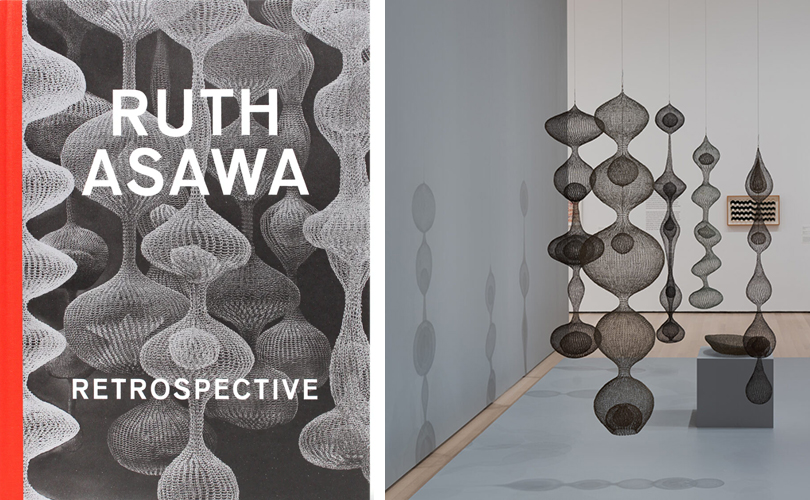
Exhibition catalogs were also the inspiration for both Karyl Sisson’s and Gyöngy Laky’s recommendation: the Ruth Asawa retrospective — first in San Francisco, now in New York. (If you are on the East Coast, you have until February 7, 2026 to see it at MoMA.) “The breadth of her work is astounding,” Karyl Sisson says. Gyöngy Laky also recommended the retrospective catalog, Ruth Asawa: Retrospective. She and her husband Tom Layton were friends with Ruth Asawa. “Thinking about Ruth Asawa reminds me that the US has overcome threats to our Democracy before,” Laky writes. “During another time challenging our democratic values, in World War II, the Asawa family members were sent to internment camps. The terrible and misguided 1942 Executive Order eventually incarcerated 120,000 people of Japanese descent. It was, however, as a child in those wretched concentration camps, that the talent and creative interests of Ruth Asawa were nurtured. In 1946, at the age of 20, Ruth went to Black Mountain College where she met her future husband, architect Albert Lanier. At Black Mountain College her drawing teacher, Ilya Bolotowsky, connected her drawing with her wire work describing it as drawing in space. She began her looped-wire sculptures there after being introduced to basketry techniques in Mexico”. The following year Asawa’s work was shown at SF MoMA for the first time — only to be the subject of an extensive retrospective nearly 75 years later.
Asawa left her mark on cultural history in other ways. She married her husband Albert in 1949 in San Francisco when interracial marriages were still illegal in many parts of the US. The partnership lasted 59 years! Asawa left a legacy within the larger Bay Area community, too. She co-founded the Alvarado Arts Workshop for elementary school children in 1968 – – now the Ruth Asawa San Francisco School of the Arts. She was deeply devoted to arts education. Laky writes that an Imogen Cunningham photo from the 1950s greeted visitors to the SFMoMA exhibition accompanied by a quote: “An artist is an ordinary person who can take ordinary things and make them special.” And, Laky says, Asawa did just that.
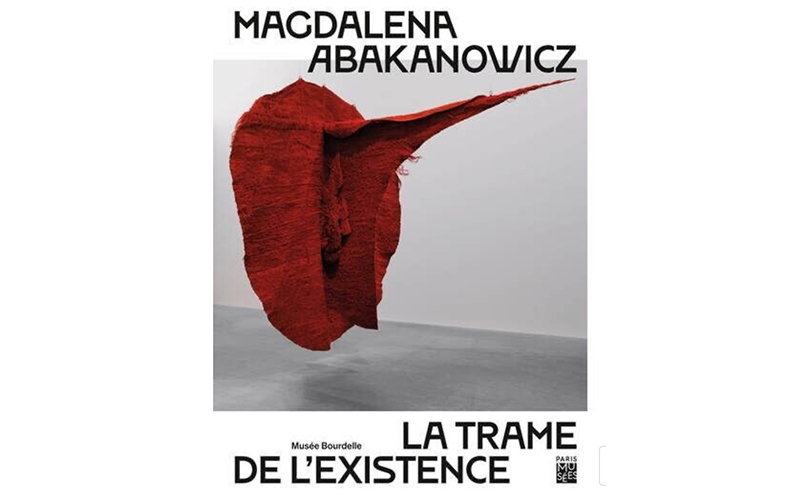
Stéphanie Jacques is looking forward to visiting Magdalena Abakanowicz: The Fabric of Life through April 12, 2026 at the Bourdelle Museum in Paris. “I love this museum and I’m excited to experience the works of Magdalena Abakanowicz. The catalog looks fascinating.” https://www.bourdelle.paris.fr/visiter/expositions/magdalena-abakanowicz-la-trame-de-lexistence In additional to exhibition attendance, Jacques has an ambitious reading list planned for next year. “Books are there to recharge us and open us up to other perspectives,” she writes. There are five books she’d like to read in early 2026:
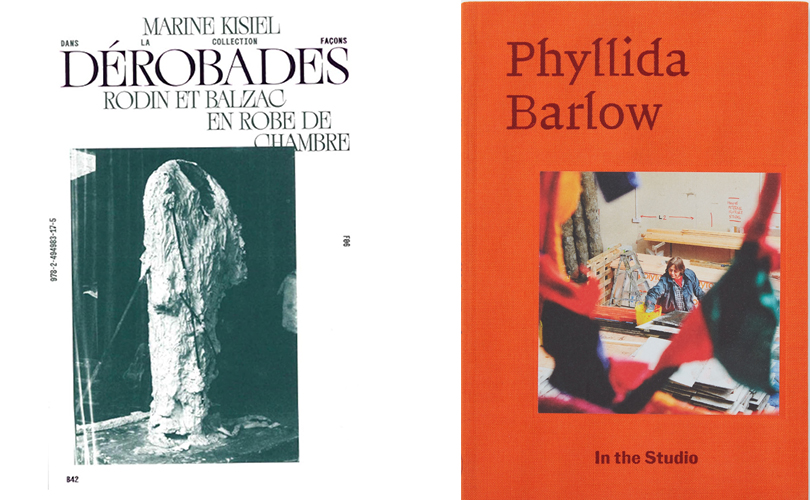
To learn more about the path Rodin took to create his sculpture of Balzac: his approach, his doubts, his relationship to the real body, etc, Jacques is going to read Dérobades: Rodin et Balzac en robe de chambre by Marine Kisiel — only available in French. “Phyllida Barlow is an artist whose work I admire,” she writes. “I haven’t yet had the chance to see her pieces in person, and this book, In the Studio: Phyllida Barlow , text by Frances Morris, seems like an opportunity to discover more about her work and her creative process. Reading about other artists’ work is enriching and often prompts me to reflect on my own practice.” Three books on basketry in all its complexity and variety are also on Jacques’ list. She describes these as, “an inexhaustible source of inspiration and wonder; skills where the universal and the unique meet.”
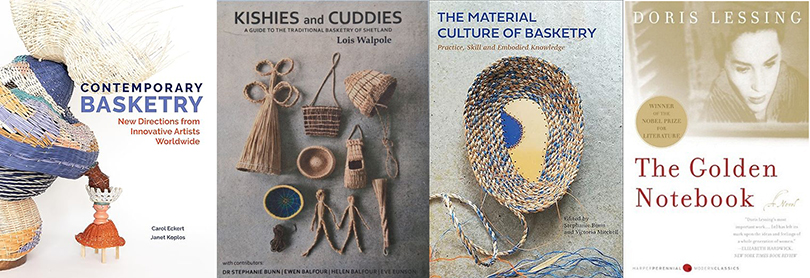
They are Contemporary Basketry: New Directions from Innovative Artists Worldwide by Carol Eckert and Janet Koplos, Kishies and Cuddies: A Guide to the Traditional Basketry of Shetland, by Lois Walpole, and The Material Culture of Basketry: Practice, Skill, and Embodied Knowledge, eds. Stephanie Bunn and Victoria Mitchell. And Jacques may return to The Golden Notebook by Doris Lessing, since she has done so regularly since first reading it over two years ago. “I have even opened it at random just to hear her voice,” she says. “It has everything: history and the upheavals of personal lives, political engagement, love, men, women, creation…”
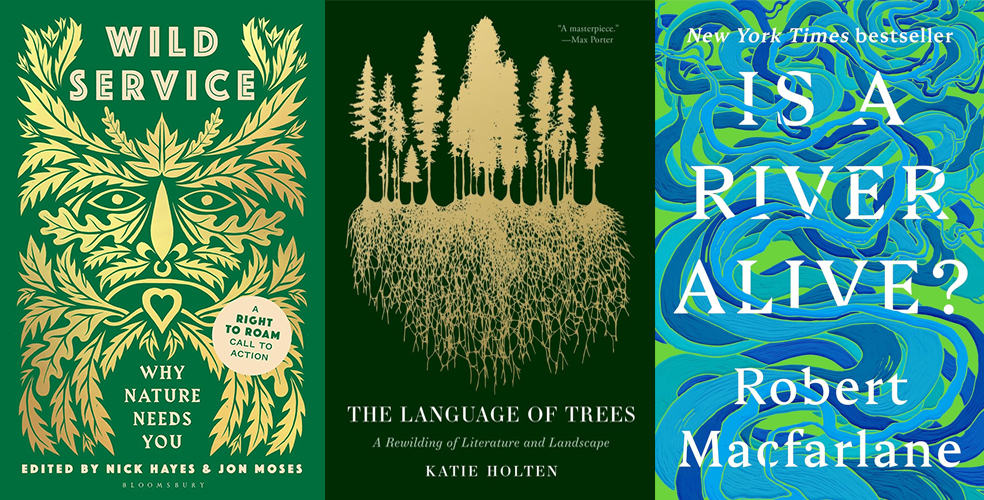
Gizella Warburton recommended three books about our relationship to nature: Wild Service: Why Nature Needs You, eds. Nick Hayes and Jon Moses, The Language of Trees: a Rewilding of Literature and Language, by Katie Holten and Is a River Alive? by Robert MacFarlane. Wild Service calls for mass reconnection to the land and a commitment to its restoration. A national bestseller, The Language of Trees invites readers to discover an unexpected and imaginative language to better read and write the natural world around us and reclaim our relationship with it. MacFarlane has been called “the great nature writer … of this generation.” The publisher says that Is a River Alive? is a joyful, mind-expanding exploration of an ancient, urgent idea: that rivers are living beings who should be recognized as such in imagination and law. They are not textile-related, says Warburton, but each offers “a hopeful and meaningful read.” Amen to that!
Next Week:
More book recommendations— this time from browngrotta arts …
Works by Norma Minkowitz, Nnenna Okore, Laura Foster Nicholson, and Gyöngy Laky made up our New this Week selection for November.
Each of these works were featured in our Fall exhibition, Beauty is Resistance: art as antidote. The exhibition highlighted artworks in which artists used beauty as a way speak about agency, identity, anxiety, environmental issues, and more.

Norma Minkowitz is widely known for works of three-dimensional crochet. For Venus Trapped, Minkowitz started with a giant crocheted flower head not really knowing where the sculpture was headed. Her initial inspiration leaned toward creating a female figure in combination with a giant flower head. But then, she started creating thorn-like shapes that resembled female fingernails painting them red. The flower, generally a symbol of renewal, peace, and celebration became a Venus fly trap — a persistent threat to certain species. Thorns and red sharp fingernails appeared to ward off any attacks — a symbol of resistance defending oneself against unwanted behavior.

Born in Australia, raised in Nigeria, and now working in the United States, today Nnenna Okore uses bioplastics as a primary material in her work. However, her present ideas around material transformation took root in earlier works like White Cowries. Okore spent a year as an apprentice in El Anatsui’s studio in Nigeria, an artist who transforms thousands of throwaway metal bottle caps, tops, and fragments into dazzling tapestries that simultaneously confront the effects of the transatlantic slave trade and affirm the majesty of West African textiles like Kente cloth. In Okore’s White Cowries, 2010 draped hessian (burlap) pulses with white clay dots to suggest the depth of symbolic, economic, and historical meaning of the cowrie shell in Nigerian culture.
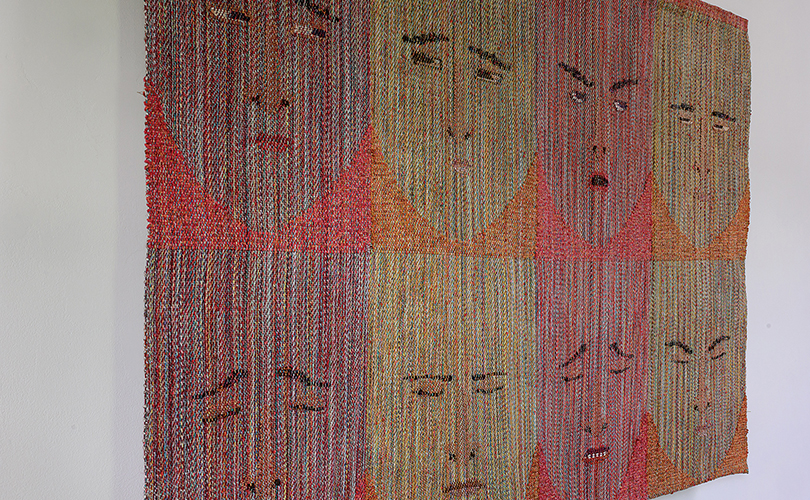
Laura Foster Nicholson is a textile artist known for her handwoven tapestries. With a BFA from Kansas City Art Institute and and MFA from Cranbrook Academy of Art, she has lectured, taught, and exhibited in the US, Canada and Italy. Her artwork is in several museum collections, including the Art Institute of Chicago, The Minneapolis Institute of Art, and the Denver Art Museum. Grants and awards include an NEA fellowship, the Leone di Pietra prize at the Venice Biennale of Architecture, three Illinois Arts Council fellowships, and a grant from the Graham Foundation for Research in the Fine Arts. She often does fabric and ribbon design commissions, including for Thomas Jefferson’s home, Monticello. “Eight Faces of Concern,” Nicholson says, “was a cathartic response to Trump’s first term. It was so much fun to get each subtle expression about these feelings into weaving. There are a lot of them!”
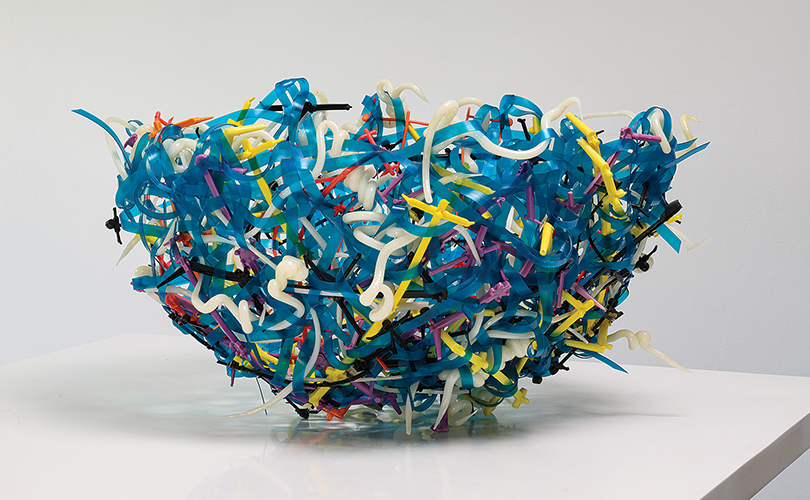
In the 90s, Gyöngy Laky was enthusiastic when the SC Johnson Wax company sent waste bits of plastic from their manufacturing process to artists to use in their work. At that time, Laky says, many artists were addressing reuse, recycling, post-consumer life for discards, but here a major company joined the conversation. Graceful Exit was the result. Laky began to call of her materials addressing sustainability “industrial harvesting.” The artist is known for her wise and witty juxtapositions of natural and manmade materials. “Laky’s art manifests architectonic sensibility. She is as much an engineer as she is an artist in the conventional sense,” Kenneth Trapp wrote in an introduction to Laky’s oral biography (Nathan, Harriet, Trapp, Kenneth (2003). Gyongy Laky (b. 1944) Fiber Art: Visual Thinking and the Intelligent Hand. Regional Oral History Office, Bancroft Library, University of California, Berkeley, CA: The Regents of the University of California).
Enjoy! More to come in December…
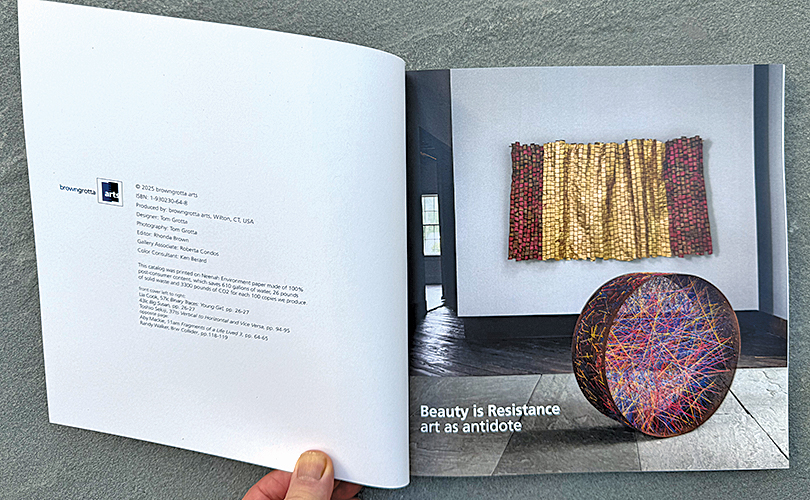
If an exhibition takes place but there is no catalog to document it, did anyone see it? Certainly not enough people have seen it, as far as browngrotta arts is concerned. That’s why we produce a catalog for nearly every exhibition we host.
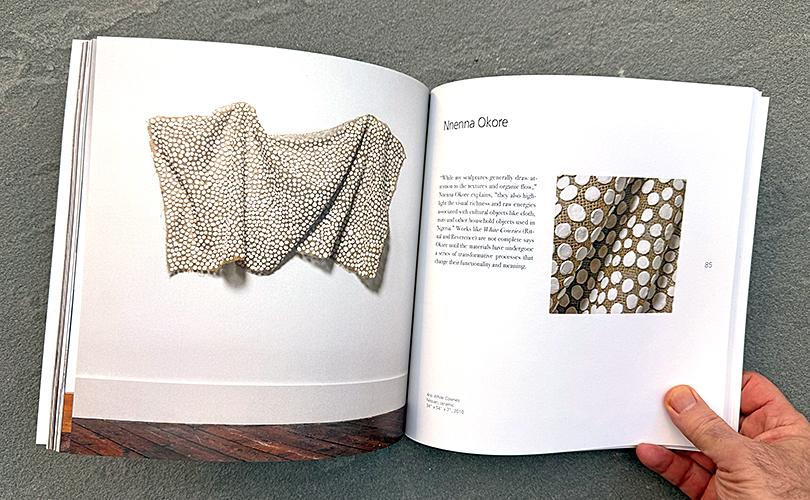
We had hundreds of people visit our Fall 2025 exhibition, Beauty is Resistance: art as antidote. But we also cowry to share the remarkable works in Beauty with even more people through our installation video and Zoom talkthrough, both on our YouTube channel, and through the print version of the show, a catalog (our 61st), available on our website.
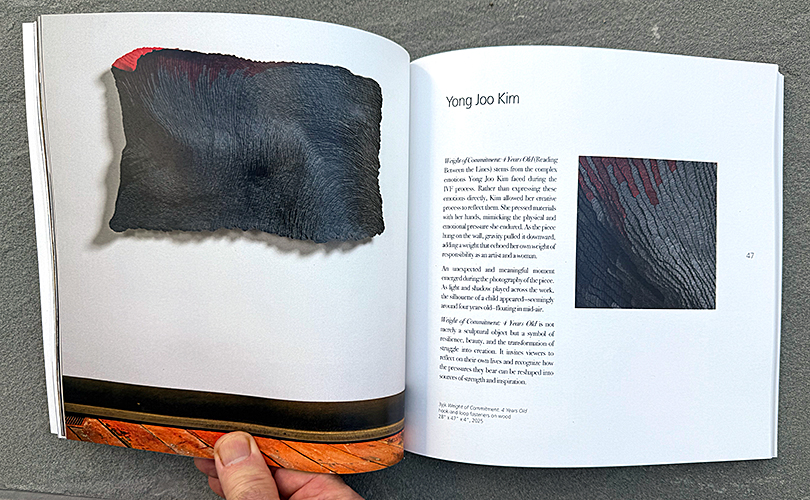
The 132-page catalog contains 125 full-color images. There are full view and detail images of each of the featured works in the exhibition. There are statements about each work in the catalog. The works in the exhibition fell loosely into four subthemes: Reading Between the Lines, Threads of Memory, Radical Ornament, and Ritual and Reverence, and the catalog identifies the category that each work falls into.
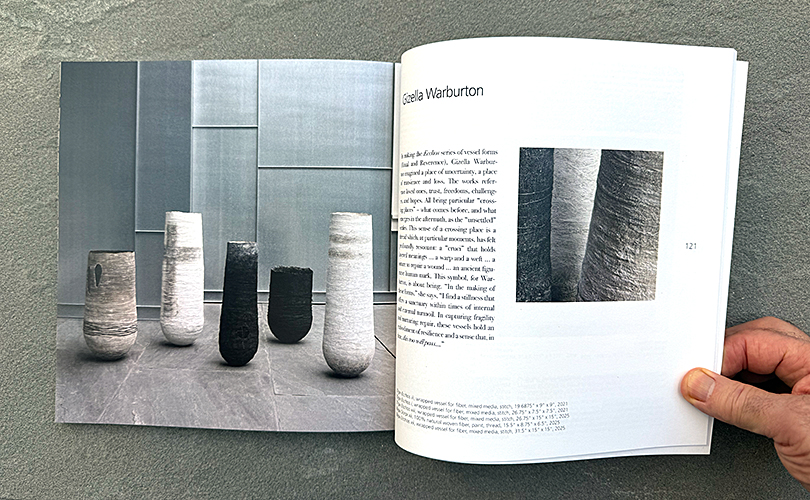
Elizabeth Essner, Windgate Associate Curator at the Museum of Art, Houston contributed an insightful essay to the catalog, “Looking at Beauty.” Essner writes about the role of nature in many of the artists’ work — for materials, lessons, and poetic inspiration. She examines varying historic conceptions of beauty, subjective, objective, and embodied, and discusses the significance of prevailing cultural aesthetics. in summarizing beauty’s pivotal place in art, Essner quotes late art critic Peter Schjeldahl (1942 – 2022) who predicted that in the future, “beauty will be what it always has been and, despite everything, is now in furtive and inarticulate ways: an irrepressible, anarchic, healing human response without which life is a mistake.”
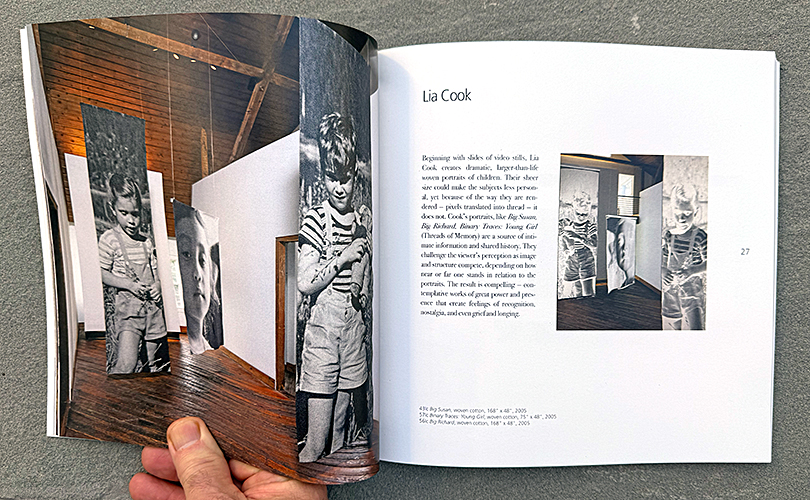
Order your copy on our website. If it’s a gift, let us know at art@browngrotta.com before December 15th and we will gift wrap your copy before we send it.
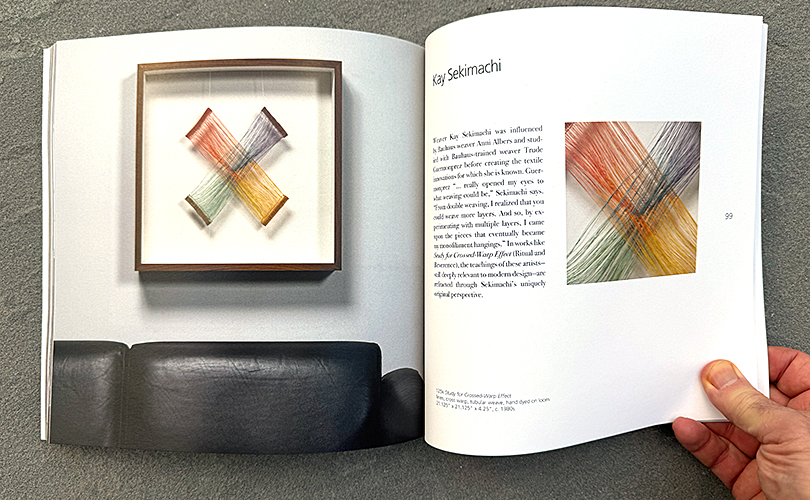
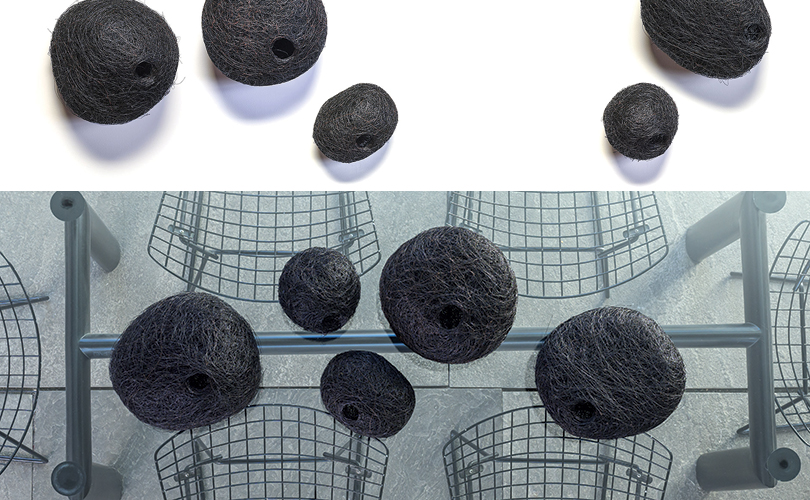
The way we experience an artwork is deeply influenced by its setting. Context—whether physical, spatial, or digital—acts as a lens that shapes how we interpret and emotionally respond to a piece. We experienced the impact of context quite graphically in the early days of browngrotta arts. Our first space had a room with a brown linoleum floor. We displayed three red-and-black canvas paintings in there — they attracted absolutely no interest. We finally sprung for a black floor. Suddenly the paintings popped, we sold the paintings within weeks to a client who’d actually seen them before, but not noticed them.
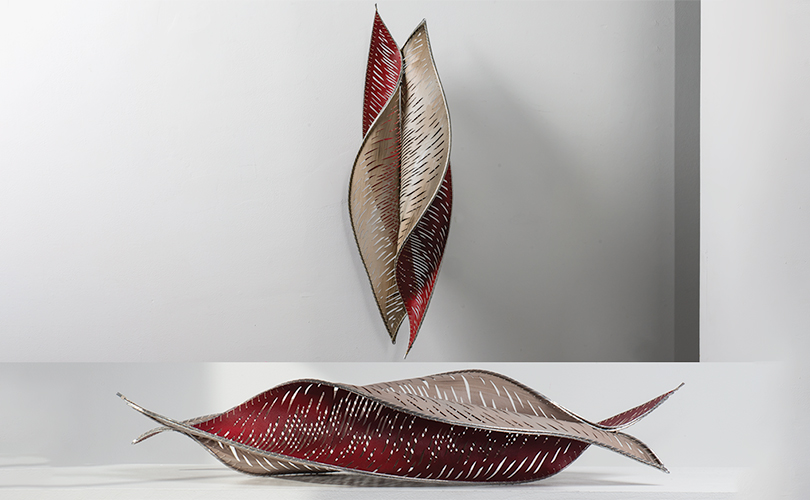
We’ve since learned more about the difference a well-thought out framing solution can make. We’ve learn to consider varying display options — on a surface and or a wall. And of course, as a hallmark of browngrotta arts, we’ve become proponents of off-the-wall installation for nearly everything. In this post we’ll talk about what a difference a display can make and we’ll illustrate that discussion with examples of works that display well — but often quite differently — when shown flat versus elevated.
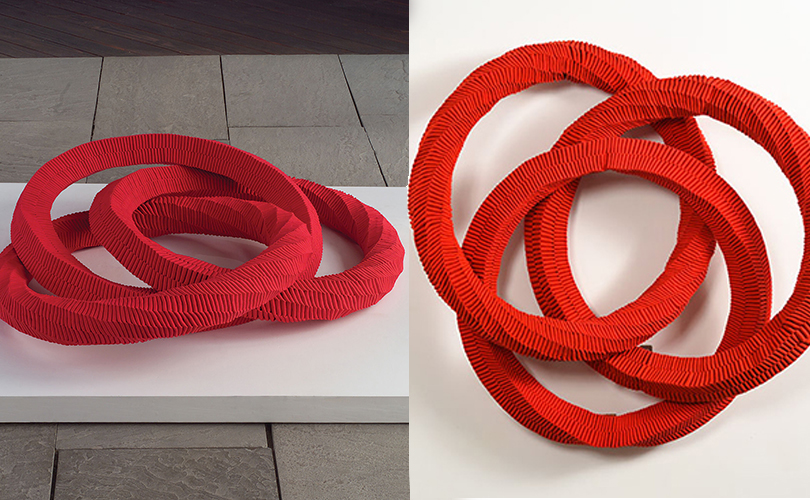
In a museum or gallery, the environment invites quiet reflection. Controlled lighting, open space, and minimal distractions encourage focused engagement. In contrast, a public space transforms viewing into a more spontaneous and social act. A mural on a busy street or a sculpture in a park becomes part of everyday movement and conversation. The artwork interacts with architecture, weather, and passersby, taking on new meanings shaped by its surroundings. browngrotta arts adopted the concept of “art in use” nearly 40 years ago. We intentionally eschew the “white cube” approach, choosing instead to show artworks in a residential setting with backgrounds of brick, wood, window, steel, and dry wall. We photograph art in the same way — including a bit of window frame or furniture for scale and for context.
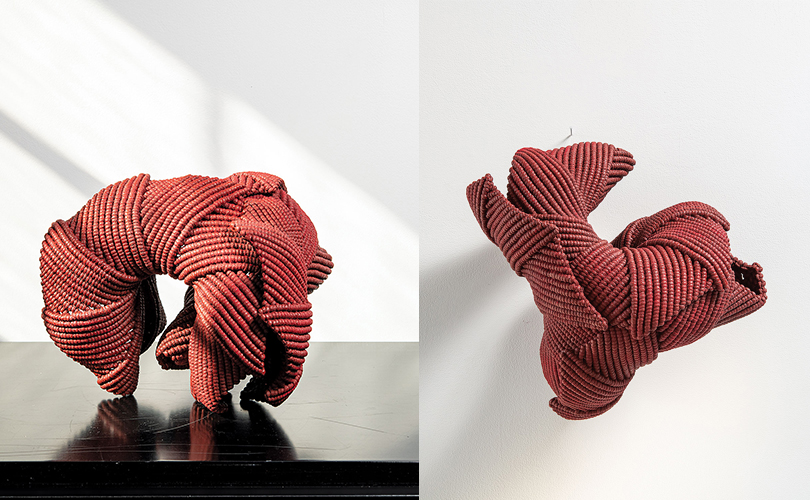
The digital versus physical context offers another layer of contrast. Seeing an artwork online or in a book provides accessibility but lacks the scale, texture, and material presence of the original. Standing before a large painting or a textured sculpture can evoke a visceral reaction that a screen cannot replicate. The digital experience flattens, while the physical presence immerses. We’d go a step further and say that viewing a fiber sculpture hung away from the wall, lit to enhance its dimension and capacity for shadow, offers an even more captivating experience.
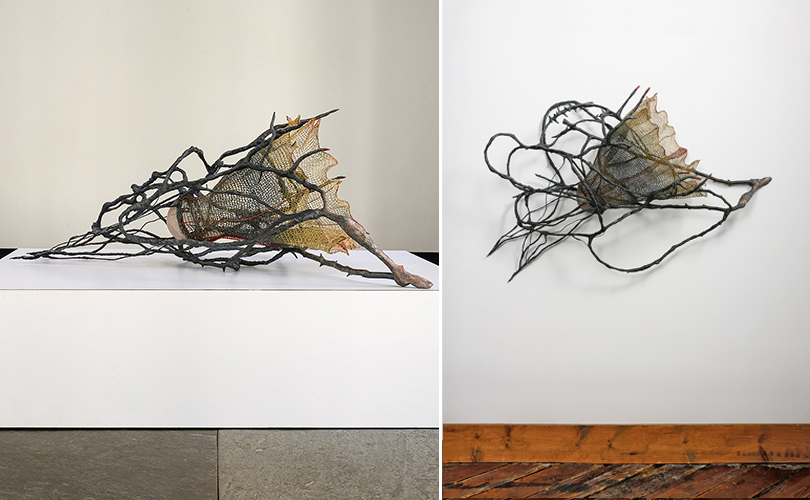
Within physical spaces, display choices significantly alter perception. An artwork displayed on a wall—such as a painting, photograph, or relief—often encourages a frontal, visual engagement. Wall art draws the eye upward and outward, transforming flat surfaces into expressions of color, movement, and meaning.The viewer remains slightly distanced, observing the work as an image or window into another world. In contrast, an artwork placed on a pedestal invites a more three-dimensional, sculptural interaction. The pedestal elevates the object, granting it importance and encouraging viewers to move around it, to see it from multiple perspectives. This spatial relationship emphasizes the artwork’s physicality and objecthood.

Finally, the adjacent works and curatorial decisions surrounding an artwork shape how it is read. A piece displayed among others with shared themes or contrasts can create narratives, tensions, or dialogues. The context of display becomes part of the artwork’s meaning.
Ultimately, no artwork exists in isolation. Whether encountered in a hushed gallery, a bustling street, a digital space, as part of curated residential collection, or elevated on a pedestal, its setting transforms not only how we see it—but also how we understand its place in the world.
Between exhibitions and catalog production we — Tom and Rhonda at browngrotta arts — try to get out and take in some art and entertainment. This October and November are no exception. We’ve been able to visit five exhibitions over the last few weeks. Three of them close shortly — on Sunday, the fourth in December. A sixth that we recommend is open until next May. We urge you to get out to see them while you can.
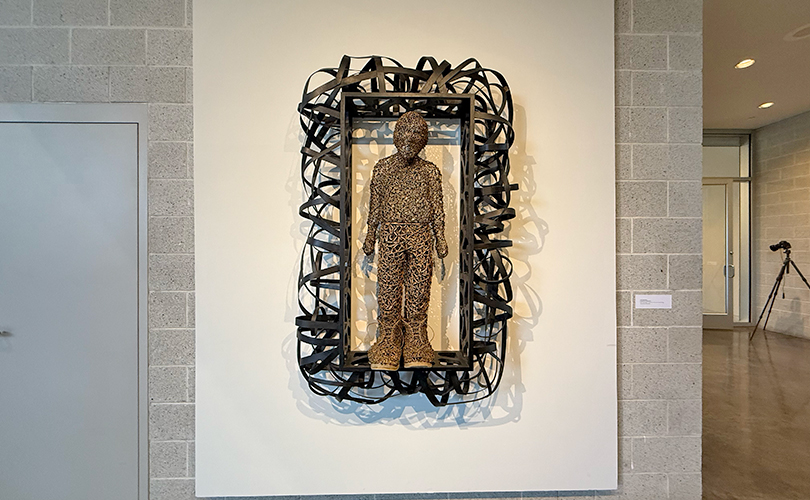
John McQueen Memorial Exhibition
The Tang Museum
Skidmore College
Saratoga Springs, NY
Through November 9th
In honor of John McQueen (1943-2025), the Tang presents the John McQueen Memorial Exhibition from November 2–9. McQueen was a conceptual fiber artist whose work was featured in the Tang exhibitions Affinity Atlas (2015) and The World According to the Newest and Most Exact Observations: Mapping Art and Science (2001). The works selected for the Memorial exhibition include McQueen’s first basket from 1975, Caught Out, a self portrait completed 35 years later, and, A Tree and its Skin. a reflective diptych sculpture that was among the artist’s favorites.
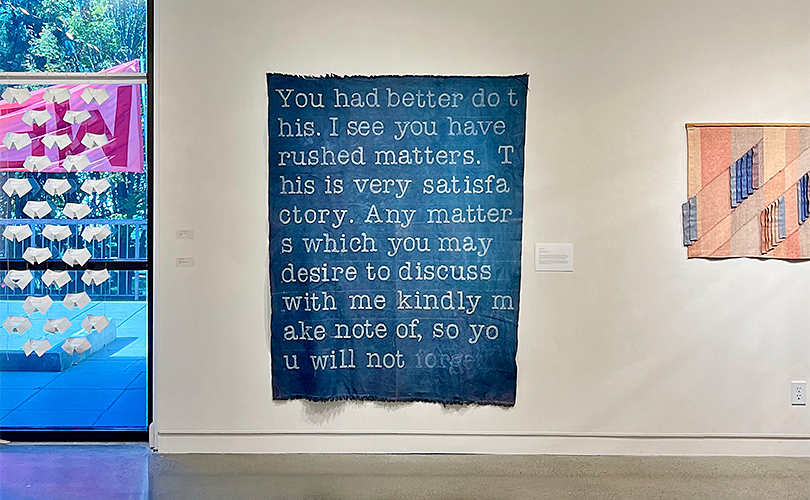
Crux of the Matter: Work by Margo Mensing and Sayward Schoonmaker
The Schick Art Gallery
Skidmore College
Saratoga Springs, NY
Through November 9th
Crux of the Matter presents work by Margo Mensing, (1941 – 2024), Skidmore College Fiber Arts professor, interdisciplinary artist and poet and Sayward Schoonmaker, Skidmore ’06, interdisciplinary artist, writer, and former student of Mensing. “Both artists play with language,” the Art Gallery notes, “using subtle humor as underpinning, and both approach their work through a conceptual lens, starting with an idea and then finding the physical form to best serve it.” Mensing’s works range from weavings and quilts to her sculptural response to Ghiberti’s 15th Century Gates of Paradise, monumental bronze doors that feature ten Old Testament scenes in square panels. Mensing’s wooden doors, also monumental, feature ten household tips (such as, “Tenderize tough meat in 1 Tbsp vinegar and 1 pint water”) each incised in a square linoleum panel.
As Mensing’s son, J. Shermeta notes, her magnum opus was her “Dead at” series. Each year beginning on her birthday, October 4th, Mensing created a presentation, or a performance centered on the life and accomplishments of a famous person who died at her current age. Starting with J Robert Oppenheimer at age 63 in 2004, Margo created artwork, poetry, and organized group performances about the lives and work of Joan Mitchell, Elizabeth Bishop, Denise Levertov, Walt Disney, Jacqueline Kennedy Onassis, Donald Judd ,and Louis Armstrong. To celebrate the life and magic of Louis Armstrong, for example, Mensing choreographed STOPTIME: Louis Armstrong Festival, bringing together musicians, artists, and performers to create over a dozen events from 4 to midnight on July 6, 2011. The Horns of Hudson band played, art teachers hosted a “Rhythm! Color! Collage!” workshop for kids, tap dancers performed and joy–inspired by the music of Louis Armstrong–was shared by all.
The Schick exhibition includes a wide range of thought-provoking works, early abstract weavings, the lovely lyrical machine-embroidered poem, you had better do this, items from the Dead at series and from other of Mensing’s projects including a group of glass pipes created as part of A Very Liquid Heaven, a multimedia installation and performance event that examined science and the universe. Also included in Crux of the Matter, are intriguing works by Sayward Schoonmaker. As the Art Center describes the collection, “from poems written in letters formed by pencil shavings, to Slice, a table with a glittering black surface interrupted by slivers of white substructure, she employs exquisite craftsmanship throughout. Her works feel like unadorned truths, simultaneously urgent and familiar, plainly-stated and enigmatic.”
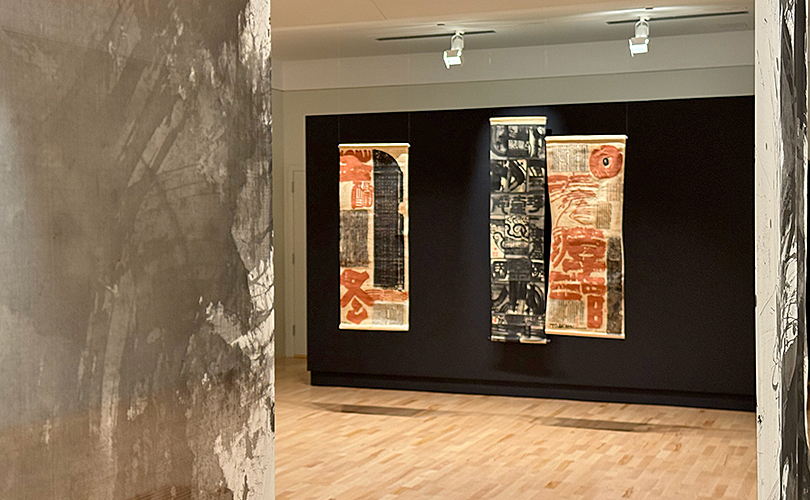
Vietnam: Tradition Upended
Flinn Gallery
Greenwich, CT
Through November 9th
In collaboration with the Art Vietnam Gallery in Hanoi, the Flinn Gallery has organized Vietnam: Tradition Upended. The exhibition was curated by Debra Fram and Barbara Richards, who have worked with browngrotta arts on previous exhibitions at the Flinn, and Suzanne Lecht from Art Vietnam Gallery. The exhibition’s origins are several years old. Fram and Richards had travelled to Vietnam in 2019 and in Hanoi met Lecht, who it turned out, had lived in Greenwich on the 80s. The three remained in contact and over the next four years, Vietnam: Tradition Upended took shape. The exhibition features nine interdisciplinary artists who work in a variety of mediums and styles. We were excited by the diversity on display and particularly taken by the mixed media works of Nguyen Cam (b.1944, Haiphong, Vietnam) and the calligraphic statements of Pham Van Tuan (b.1979, Thanh Hoa province, Vietnam), 35 years his junior.
As The Flinn notes, the artists in Vietnam: Tradition Upended all take time-honored traditions and materials and rework them in a modern context, acknowledging the past while simultaneously breaking away. With 2025 marking exactly half a century since the end of the Vietnam War, and 30 years since the normalization of relations between Vietnam and the U.S., this is an opportune time to acquaint ourselves with the art and culture of a country that has undergone extraordinary change; a country with one of the most interesting and vibrant art scenes in Southeast Asia.
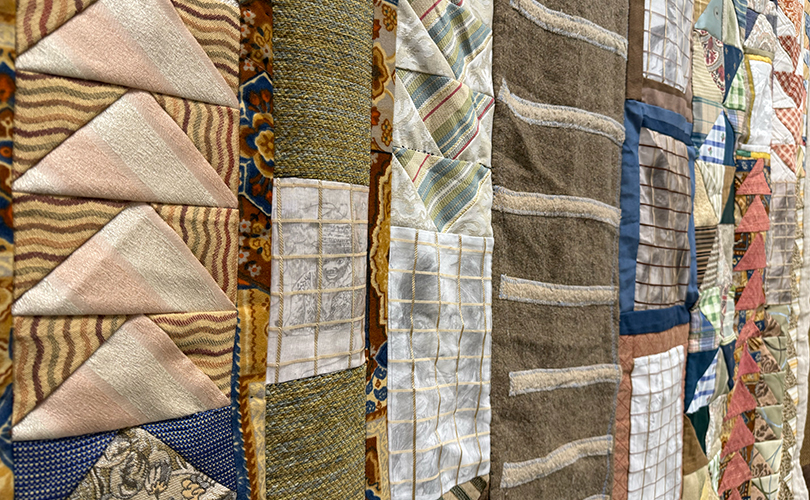
Stitching Time: The Social Justice Collaboration Quilts Project
Fairfield Gallery Art Museum/Walsh Gallery
Fairfield, CT
Through December 13, 2025
Stitching Time features 12 quilts created by men who are incarcerated in the Louisiana State Penitentiary, also known as Angola Prison. We listed the exhibition here a few weeks ago, but having the chance to see the creativity and careful creation of these works in person was a treat. These works of art, and accompanying recorded interviews, tell the story of a unique inside-outside quilt collaboration. The exhibition focuses our attention on the quilt creators, people often forgotten by society when discussing the history of the U.S. criminal justice system. Also on view in the gallery is Give Me Life, a curated selection of strong works from women artists presently or formerly incarcerated at York Correctional Institution, a maximum security state prison in Niantic, Conn., courtesy of Community Partners in Action (CPA). The CPA’s Prison Arts Program was initiated in 1978 and, operating since 1875, it is one of the longest-running projects of its kind in the United States. The quilts and CPA artworks are poignant, hopeful, and often aesthetically impressive. If you can’t visit by December, check out the exhibition’s website where you’ll find images, videos, and a flip-through catalog.
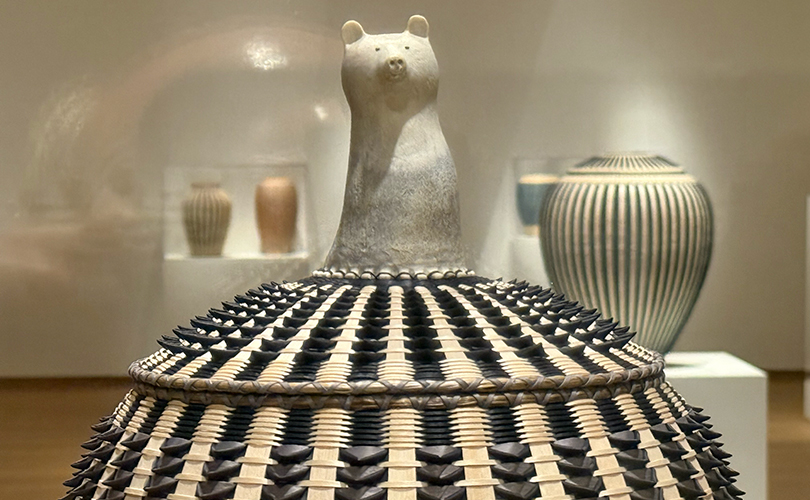
Jeremy Frey: Woven
The Bruce Museum
Greenwich, CT
Closed
We visited Jermey Frey: Woven at the Bruce Museum just before it closed at the end of October. Frey’s virtuosity as a seventh-generation basketmaker, steeped in the Passamaquoddy tradition, was clearly evident in this remarkable retrospective. However, we were also excited and surprised to see Frey’s prints, which were striking. The exhibition had traveled from the Portland Museum of Art and if you missed it in Maine or Greenwich, there are many resources you can access to see the works that were included and learn about Frey’s meticulous process. There are images of 18 works and links to several articles from ArtDaily to The New York Times on the PAM website. There are also links to videos about the artist.
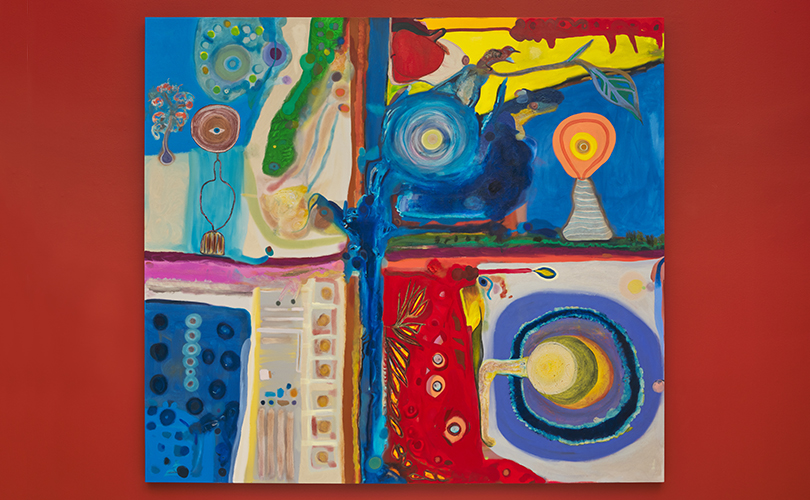
Uman: After all the things
The Aldrich Contemporary Art Museum
Ridgefield, CT
Through May 10, 2026
We have not had a chance to visit Uman: After all the things at the Aldrich Museum in Ridgefield, Connecticut but we will. As the Museum observes, “Uman’s practice, which spans painting, works on paper, murals, sculpture, and glass, is about color that is felt and content that is experienced. Under the influence of memories, dreams, and change, her visual language is intuitive, multilayered, adaptable, and free; neither exclusively abstract nor metaphorical, it proliferates in the indeterminate and transcendent.” Uman says that her work “offers an escape …. [m]y work is its own activism.” She wants her work to “feel good for the audience.” This is an approach also taken by some of the artists in browngrotta arts’ recent exhibition, Beauty is Resistance: art as antidote. We look forward to being engaged, uplifted, and inspired.
Hope you’ll get a chance to view one or more of the exhibitions, in-person or online.
October was another month of intriguing artworks.; we featured four works from our recent exhibition, Beauty is Resistance: art as antidote. In Beauty, we celebrated artists for whom aesthetic creation serves as a form of radical defiance, cultural preservation, and political voice. In the exhibition, international artists spanning generations and geographies, challenged the notion of beauty as mere indulgence and reframed it as a tool for protest, remembrance, and imagination.
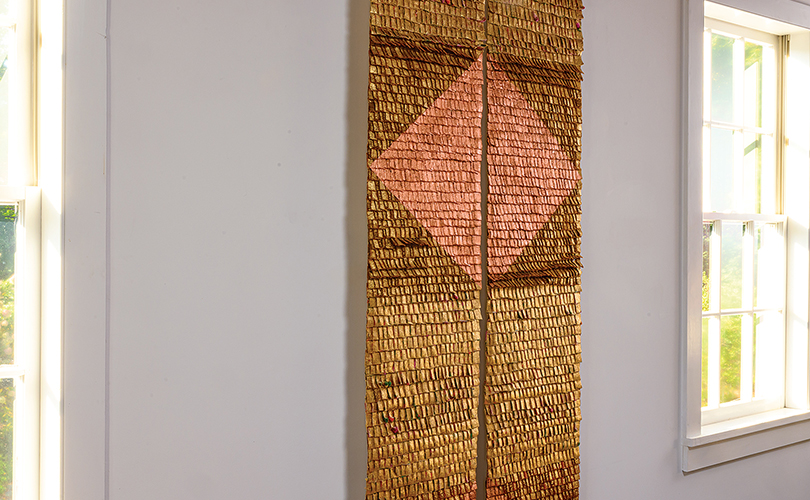
First up was Aby Mackie’s Fragments of a Life Lived 3 made in 2025. Mackie’s textile-based artwork engages with themes of ecology, history, and resistance through a process of reclamation and transformation. Working with discarded historic textiles, she deconstructs and reconfigures them—disrupting their original function to create new meaning. In Fragments of a Life Lived 3 she used antique-ticking fabric as both material and metaphor. Once utilitarian, worn by time and use, the fabric is reconstructed through stitching and further manipulated with paint and gold leaf. These interventions reimagine its surface to form layered, disrupted visual narratives—echoing stories of erosion, endurance, and renewal. The use of gold leaf requires viewers to stop and consider what should be valued and what should be discarded.
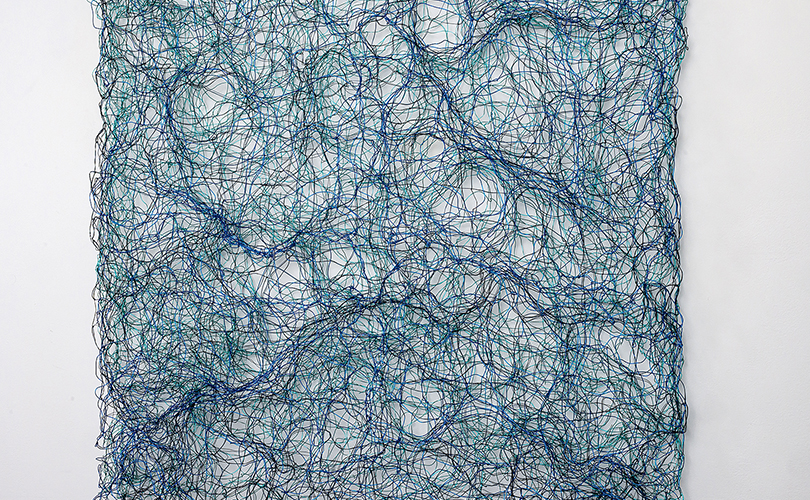
Next we focused on Ocean by Nancy Koenigsberg. The work is a meditation on movement and endurance, rendered in wire—an industrial material shaped into an evocation of tides, currents, and undertow. The piece positions material practice as a form of quiet defiance—an insistence on remembering, marking, and enduring. “The work is concerned with ecology,” Koenigsberg says, “as I’ve been very perturbed by the recent flooding and storms across the country.”
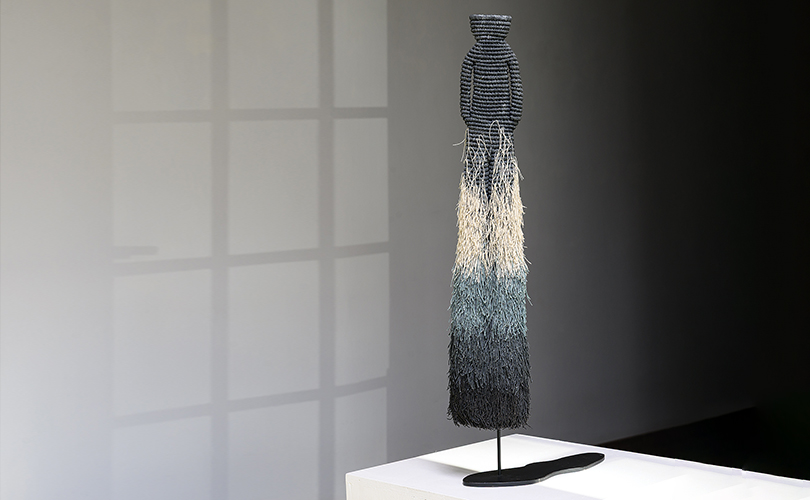
In Grey Shadow, by Mary Giles, the human figure is used both as a formal reference and as an element of commentary. Throughout her career, Giles investigated various media including waxed linen, porcupine quills, and a number of metals like copper and iron. Giles often used coiling—a process associated with Native American basket traditions—to move between two and three dimensions in her sculpture. Giles said of her work, “I interpret and express explored communication and intimacy in relationships. The results are reflected in my figural work. I admire the directness and honesty I see in tribal art and I try to incorporate those qualities in my own.”

The last work we looked at in October was Luster of Time, by Neha Puri Dhir. Dhir‘s textile study has been broad based, including time at the National Institute of Design, Ahmedabad, India, studies in Italy, Latvia, the UK, and a workshop with Americans Yoshiko Wada and Jack Larsen. Dhir has intentionally explored a variety of textile techniques, developing a particular appreciation for shibori and stitch resist. The delicate lines and textures in Luster of Time, evoke the beauty of aging and the stories embedded in the passage of time. The deep circular form at the center suggests a meditative stillness, grounding the viewer amidst the rhythmic folds. This piece celebrates time as a collaborator, turning fabric into a canvas where aging itself becomes a mark of grace and resilience.
If you’d like to learn more about the works in Beauty in Resistance you can purchase a catalog on our website or join us at a talkthrough of images from the exhibition on Zoom, Art on the Rocks: an art talkthrough with spirits, on November 11, 7 pm EST.
It’s an exciting art autumn in the US. Below, the 411 on several exhibitions worth visiting., coast to coast
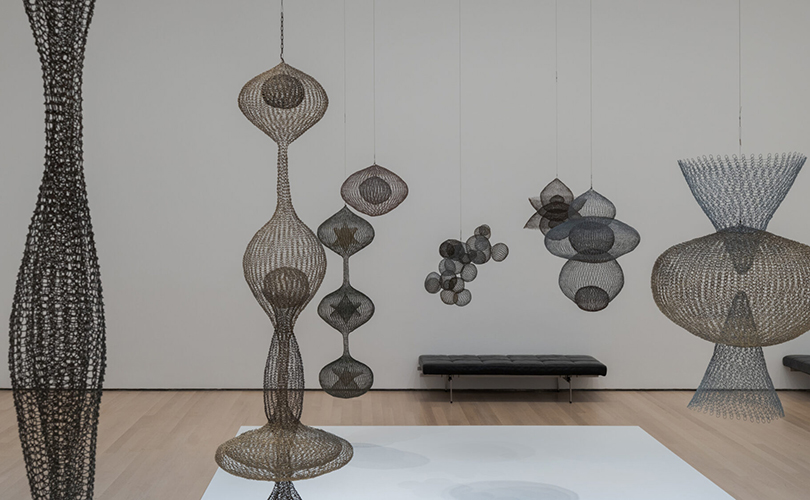
Ruth Asawa: Retrospective
Through February 7, 2026
Museum of Modern Art
11 West 53rd Street
New York, New York
https://www.moma.org/calendar/exhibitions/5768
An expansive retrospective of the eloquent work of Ruth Asawa has traveled to New York from San Francisco MoMA. The exhibition coincides with the artist’s 100 birthday, the exhibition includes some 300 objects that highlight the core values of experimentation and interconnectedness pervading all dimensions of Asawa’s practice. The retrospective spans 60 years of Asawa’s ambitious career, presenting a range of her work across mediums, including wire sculptures, bronze casts, paper folds, paintings, and a comprehensive body of works on paper. The artworks are accompanied by a rich array of archival materials—photographs, documents, and ephemera—that illuminate her public commissions, art advocacy, and meaningful, lasting relationships with members of her community.
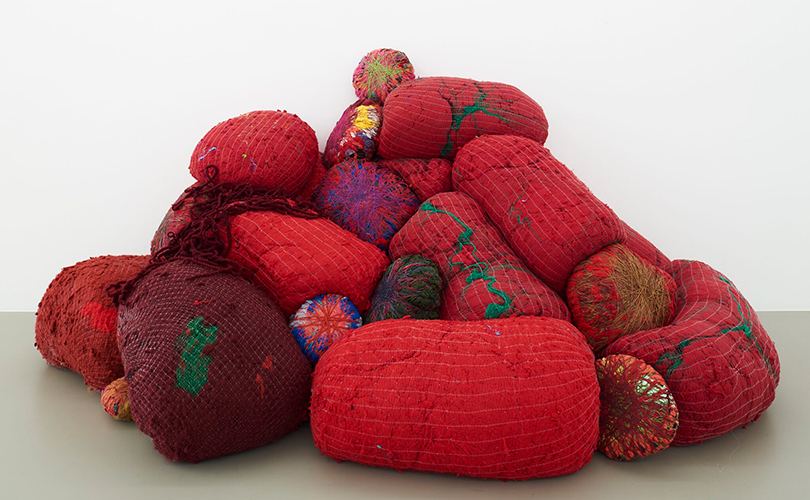
New Work: Sheila Hicks
Through August 9, 2026
San Francisco Museum of Modern Art
151 3rd Street
San Francisco, California
https://www.sfmoma.org/exhibition/new-work-sheila-hicks/
Still at SFMoMA is Sheila Hicks’s first solo exhibition there, a site-specific installation in the museum’s New Work gallery. According to the museum, the works are inspired by objects, textures, and patterns observed in her adopted city or in her migratory life. Each draws from places with personal significance, from the cobblestones of her courtyard to the towering lighthouses of the rocky island of Ouessant, France and its treacherous and rugged landscape.

On Loss and Absence: Textiles of Mourning and Survival
Through March 15, 2026
Art Institute of Chicago
159 East Monroe Street
Chicago, Illinois
https://www.artic.edu/exhibitions/9772/on-loss-and-absence-textiles-of-mourning-and-survival
In the center of the country is a themed exhibition at the Art Institute in Chicago. Drawn primarily from the museum’s collection, On Loss and Absence brings together over 100 objects from diverse cultures dating from antiquity to today to reveal the ways people use textiles to sustain spiritual beliefs, understand death, cope with grief, remember those who have passed, and heal from trauma, both personally and collectively.
Back on the East Coast, there are five exhibitions of interest — two in Connecticut, two in New York and one in New Jersey.

Stitching Time: The Social Justice Collaboration Quilts Project
Through December 13, 2025
Fairfield University Art Museum
1073 Benson Road
Fairfield, Connecticut
https://www.fairfield.edu/museum/exhibitions/current-exhibitions
At the Fairfield University Art Museum, Stitching Time features 12 quilts created by men who are incarcerated in the Louisiana State Penitentiary, also known as Angola Prison. These works of art, and accompanying recorded interviews, tell the story of a unique inside-outside quilt collaboration. The exhibition focuses our attention on the quilt creators, people often forgotten by society when discussing the history of the US. criminal justice system. Also on view in the gallery will be Give Me Life, a selection of works from women artists presently or formerly incarcerated at York Correctional Institution, a maximum security state prison in Niantic, CT, courtesy of Community Partners in Action (CPA).
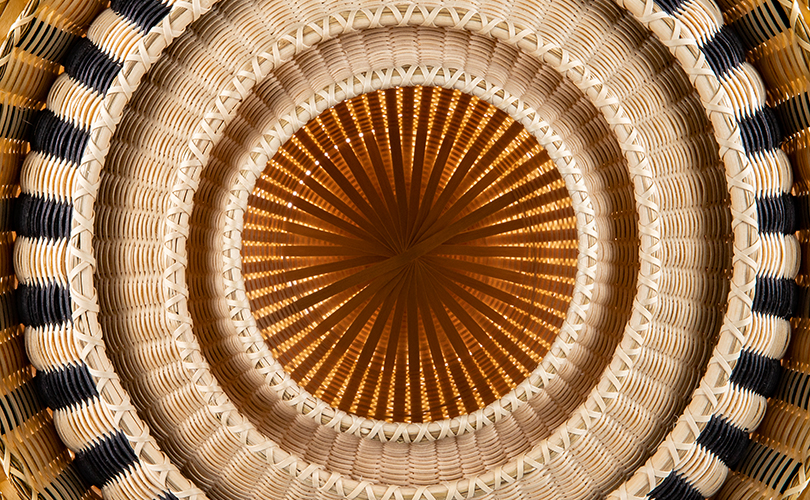
Jeremy Frey: Woven
Through October 26, 2025
The Bruce Museum
1 Museum Drive
Greenwich, Connecticut
https://brucemuseum.org/exhibitions/jeremy-frey-woven/?gad_source=1&gad_campaignid=19816342960&gbraid=0AAAAADFvx1CiuOUzWvTKKQPD8aRSirAut
You have just a few days to see the first major retrospective of Jeremy Frey’s work. Jeremy Frey: Woven presents a comprehensive survey — 50 baskets — from 20 years of Frey’s prolific career. A seventh-generation Passamaquoddy basket maker and one of the most celebrated Indigenous weavers in the country, Frey learned traditional Wabanaki weaving techniques from his mother and through apprenticeships at the Maine Indian Basketmakers Alliance. While Frey builds on these cultural foundations in his work, he also pushes the creative limits of his medium, producing conceptually ambitious and meticulously crafted baskets that reflect not only his technical skill as a weaver but also his profound ecological knowledge of and connection to the Passamaquoddy ancestral territory of the Northeastern Woodlands.
In New York City there are two opportunities to celebrate the work of remarkable artist Kay Sekimachi, who turned 99 last month.

Kay Sekimachi: a personal archive
Through November 1, 2025
Andrew Kreps Gallery
394 Broadway
New York, New York
https://www.andrewkreps.com/exhibitions/kay-sekimachi2
This exhibition of works by the Berkeley-based artist Kay Sekimachi, was organized in collaboration with browngrotta arts. It includes rare, early works from Sekimachi’s personal archive — weavings and assemblages. The exhibition is the first of the artist’s work in New York since 1970.
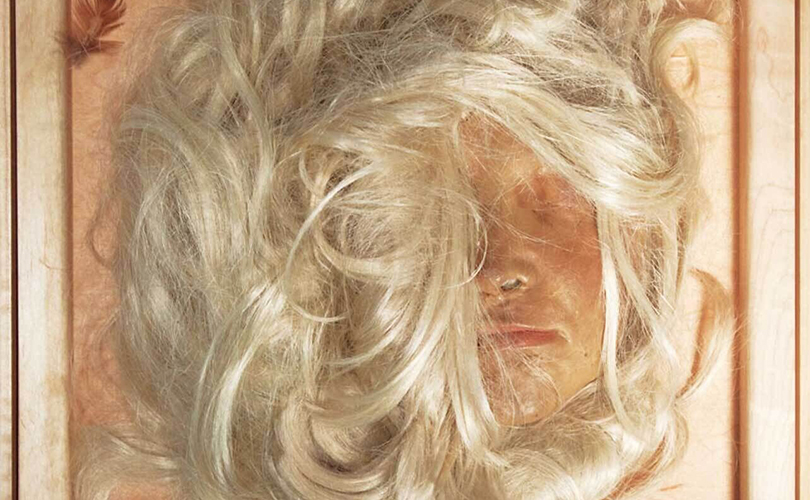
Sixties Surreal
Through January 19, 2026
Whitney Museum of Art
99 Gansevoort Street
New York, New York
https://whitney.org/exhibitions/sixties-surreal
One of Kay Sekimachi’s innovative and celebrated monofilament weavings is included in Sixties Surreal at the Whitney. Sixties Surreal is an ambitious, scholarly reappraisal of American art from 1958 to 1972, encompassing the work of more than 100 artists. This revisionist survey looks beyond now canonical movements to focus instead on the era’s most fundamental, if underrecognized, aesthetic current—an efflorescence of psychosexual, fantastical, and revolutionary tendencies, undergirded by the imprint of historical Surrealism and its broad dissemination. The exhibition is accompanied by a comprehensive catalog and a playlist.
And in New Jersey …
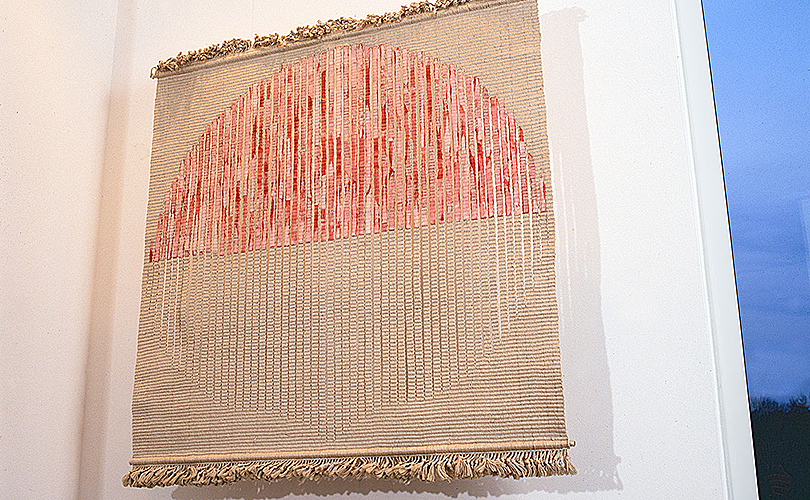
Toshiko Takaezu: Dialogues in Clay
October 31, 2025 – July 5, 2026
Princeton University Art Museum
Princeton University Campus
Princeton, NJ
https://artmuseum.princeton.edu/exhibitions-events/exhibitions/toshiko-takaezu-dialogues-clay
The groundbreaking ceramic artist Toshiko Takaezu (1922–2011), who taught at Princeton University for almost three decades will be celebrated in Toshiko Takaezu: Dialogues in Clay beginning October 31st. Drawing from the Museum’s deep holdings of Takaezu’s ceramics, Dialogues in Clay explores the artist’s experimental practice, including her signature “closed” forms and painterly glazing. Placing Takaezu’s sculptures in conversation with the work of teachers and contemporaries who embarked on parallel pathways of innovation—including Helen Frankenthaler, Maija Grotell, Robert Motherwell, Isamu Noguchi, Lenore Tawney, and Peter Voulkos,— alongside reflections by her students, the exhibition positions Takaezu as one of the most important ceramic artists of the twentieth century.
Much to Enjoy!
The weather’s changing here in Connecticut. Sweaters come out of storage, and sandals and sleeveless shirts are packed away. Light-colored duvets give way to warmer quilts and flannels. Pumpkins appear on porches and shelves, paving the way for twinkling lights in December.
What if we gave our art collections the same seasonal revisit?
The Japanese embrace this idea through a practice called kisetsukan, or “seasonal sense” — an aesthetic and cultural principle deeply rooted in their appreciation of nature and the home. This approach doesn’t just apply to art but extends to festivals, food, clothing, and everyday life. Kisetsukan reflects an awareness of the seasons and their emotional impact — something echoed in many cultures.

Substituting artwork throughout the year can shift one’s emotional response and renew our connection with both the art and the environment around us. A single piece viewed in spring might evoke freshness and renewal; that same piece in the depths of winter could feel nostalgic or even melancholy.
One beautiful example is Paul Furneaux’s City Trees II, City Lights II, a memory of a hidden park in Tokyo where luminous white and pale pink cherry blossoms contrasted against dark-barked pines and the brutalist concrete and glass of the surrounding buildings — a moment of heightened beauty and tension. Works like this could be rotated in and out as the days lengthen or shorten, responding to the mood of the season.
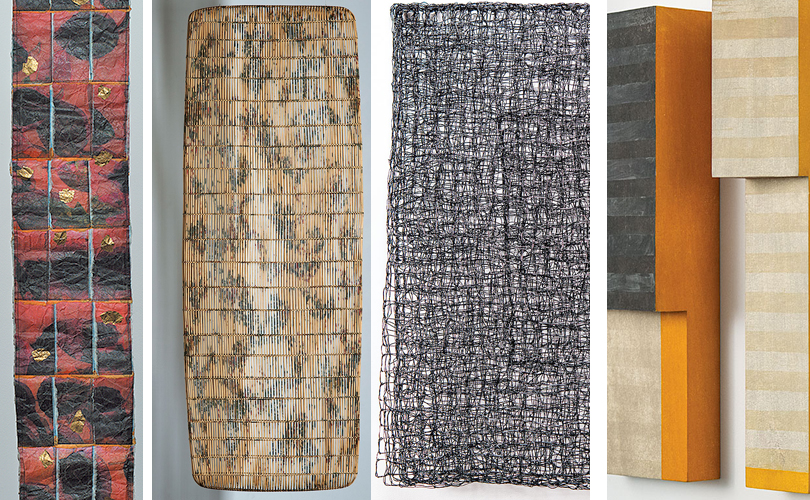
Rotating your artwork seasonally can:
You don’t need to collect four new works for each season to begin. Start small. Instead of grouping similarly sized pieces, try alternating light and dark palettes, or switching black and white for bold color.
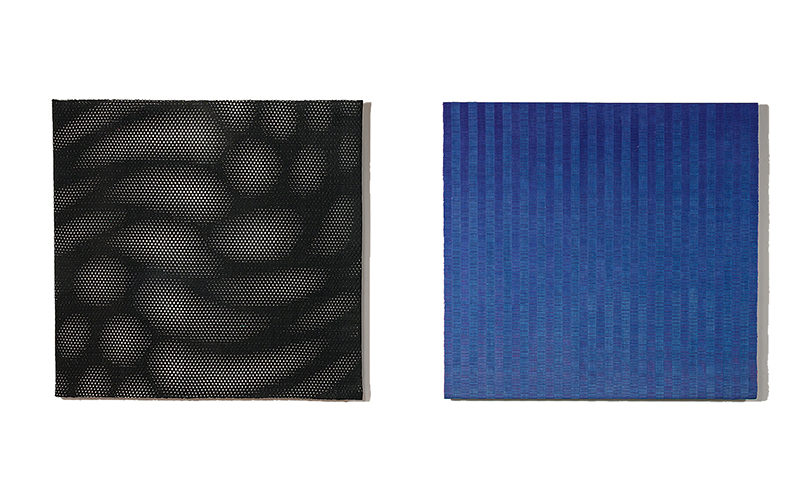
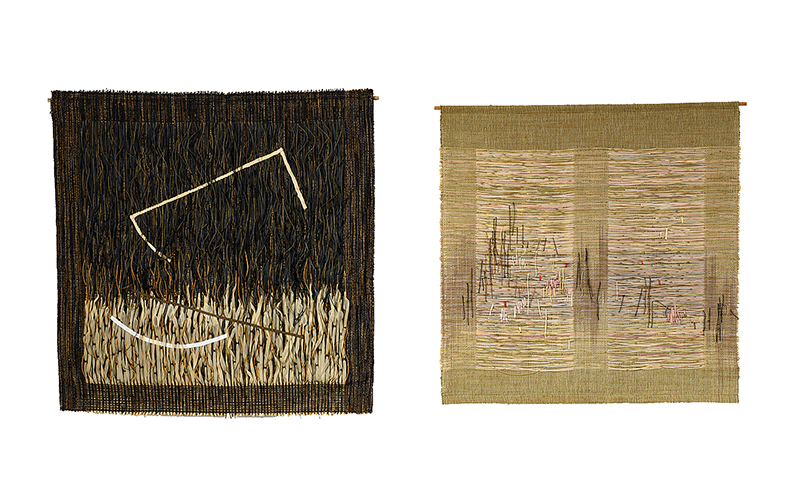
Some pieces even offer built-in versatility:
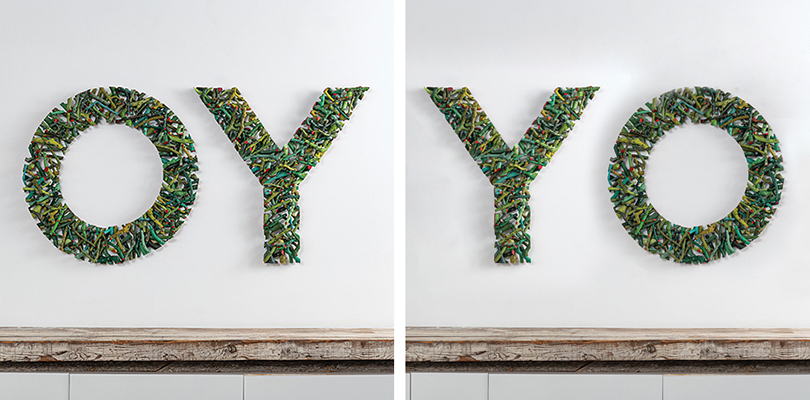

Laura Foster Nicholson’s work Shed can be hung vertically or horizontally, allowing a shift in visual weight and direction.

Sung Rim Park’s Beyond series can be installed on or off the wall, offering new perspectives and levels of engagement.
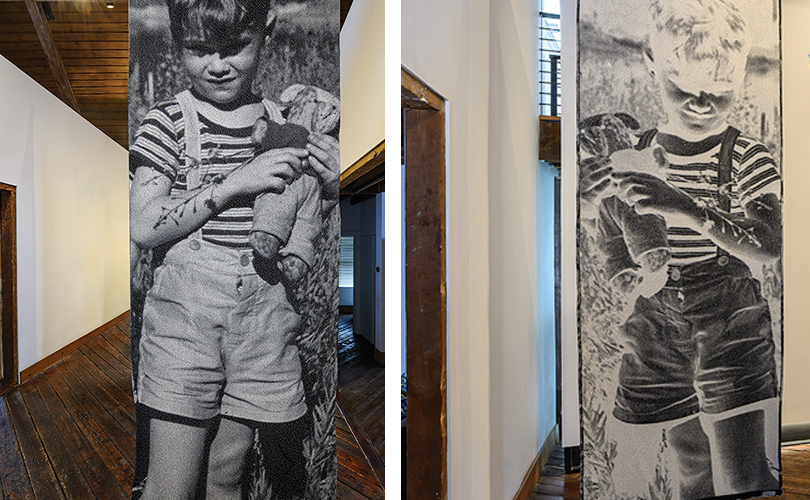
Lia Cook’s banners, like Big Richard, are impactful whether viewed from the front or reversed — another way to surprise the eye.
The more flexible the installation options, the more enjoyment you may find in your collection. Changing your art throughout the year brings new energy into a space, reawakens your senses, and reminds you of the beauty in change itself.
Copyright © 2014-2025 arttextstyle | Powered by WordPress | Design by Iceable Themes
